I am a theorist working in gravitational physics and relativistic astrophysics. I am particularly interested in the regime where gravity and/or electromagnetism are strong (dominating the dynamics), which hosts interesting theoretical questions and abundant astronomical mysteries. (If you ask me, the two are related!) How do pulsars work? How can we observe black holes? In general, my goals are to better understand the laws of nature at strong field, and to explain or predict the behavior of strong-field objects. Below I describe my efforts.
Emission from Near Black Holes
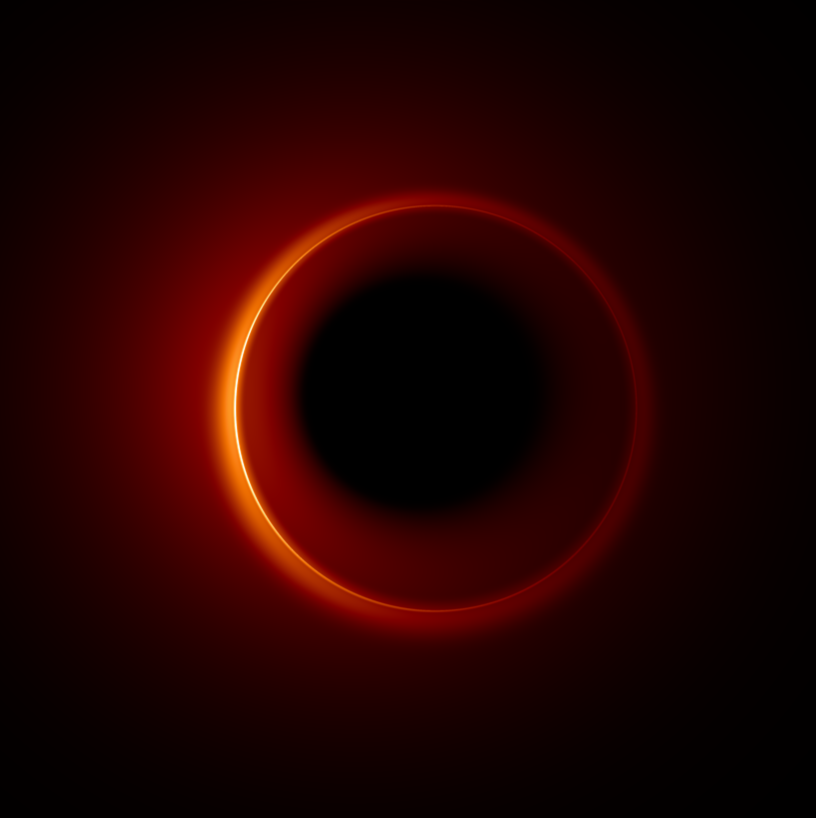 A model for the time-averaged
observational appearance of M87*, showing the stacked
"photon rings" created by photons that orbit the black
hole before arriving at the detector.
|
|
Understanding Black Hole Images
A key challenge for interpreting the results of horizon-scale VLBI observations (i.e., Event Horizon Telescope) is disentangling the "astrophysics" (details of the emitting matter) from the "relativity" (effects of the black hole spacetime). By clarifying the meaning and (lack of) relevance of certain standard heuristic interpretations, we argued that present observations are primarily sensitive to the astrophysics, with spacetime information much more difficult to glean. To lay a foundation for the interpretation of future observations, we have systematically studied the propagation of light (null geodesics) in the Kerr spacetime. We have analytically solved the null geodesic equation and characterized the behavior of the solutions in terms of the observational appearance of sources. For the "direct" emission (photons that do not orbit), the black hole has little qualitative influence on the motion, such that one sees a relatively undisturbed image of the source. For highly lensed emission (orbiting photons), there is a distinctive pattern of multiple images that is characterized by three "Kerr critical parameters" that we introduce. These parameters are in principle observable, and carry detailed information about the underlying Kerr metric.The Shape of the Photon Ring: A Precise Test of the Kerr Metric
General relativity predicts that any image of emission from near a black hole will contain a sequence of increasingly narrow "photon rings", caused by light that has orbited the black hole before arriving at the detector. I calculated the detailed observational signature of these rings on long interferometric baselines, which encodes their full, precise shape. We showed that this shape is a remarkably precise prediction of general relativity, independent of the astrophysical source, and forecast that a space interferometer could measure the shape of the photon ring from M87* to sub-sub-percent precision. This would provide the first precision test of the Kerr black hole prediction of Einstein's theory.How narrow is the M87* ring?
The Event Horizon Telescope's groundbreaking observations of M87* established the presence of a ring feature of approximately 40 micro-arcseconds in diameter. The fractional width of the ring (whether it is narrow or fat) was largely unconstrained by their analysis. Furthermore, some methods of data analysis suggested an extremely narrow ring of only a few micro-arcseconds in width, which would be very hard to explain based on conventional ideas about the source. In order to understand these issues better we have re-analyzed the public dataset, reproducing some of the EHT results and introducing new methods. In particular, we point out that arbitrary choices must be made when constructing a likelihood function for the closure phase and amplitude and explore a variety of such choices. Our results show that the fractional width is sensitive to these choices, which motivates more research determining which choices are most reliable.Rapidly Spinning Black Holes
When a black hole spins very near the theoretical maximum, its "throat" becomes very long and gains additional emergent symmetries. My colleagues and I have been exploring the implications for theoretical physics and astrophysics. We have discovered connections to black hole instabilities as well as identified two "smoking gun" astronomical signatures of a high-spin black hole. 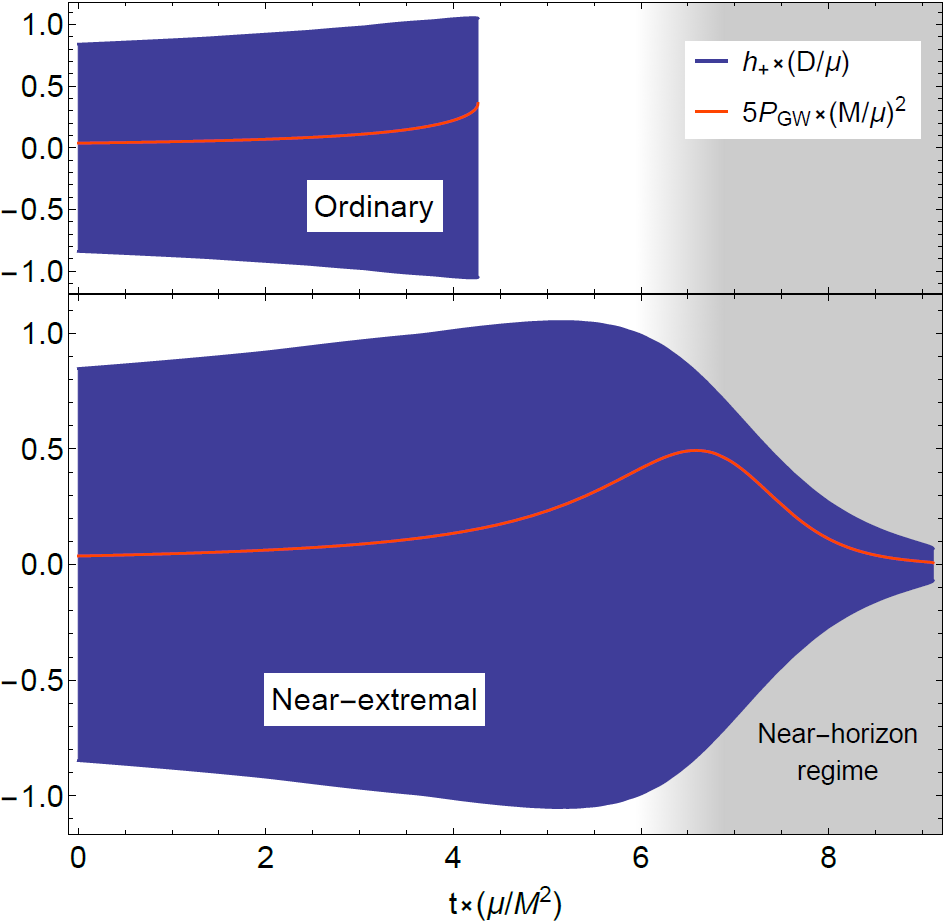 Gravitational waves from a compact object
orbiting a rapidly rotating black hole end with a slow
"song" rather than the typical "chirp" of lower-spin
sources.
|
|
Gravitational radiation: a song, not a chirp
Gravitational waves from black hole binaries generally end with a "chirp": a rapid rise in amplitude and frequency. We considered a compact object orbiting a high-spin black hole and found that the waves instead "sing": the signal sits on one frequency and slowly dies away (see figure). This signal can in principle be seen with both LIGO and LISA, and its observation would constitute a "smoking gun" for a near-extremal black hole in nature. Amusingly, the black hole "Gargantua" from the movie Interstellar is rapidly rotating and in-band for LISA. Perhaps LISA will discover Gargantua!Horizon-scale imaging: vertical motion
VLBI observations can now resolve event-horizon scales of astronomical black holes. However, the light itself originates from nearby matter, and it is difficult to infer properties of the black hole given imperfect knowledge of the source. In particular, the appearance of a given source depends only weakly on spin. However, there is unique property of very rapidly spinning black holes: all light from the near-horizon region appears on a vertical line in the image. In particular, if a "hot spot" orbits in the equatorial plane very near the black hole, it appears to move vertically instead of horizontally! This effect is caused by the extreme gravitational lensing of the long black hole throat, and its observation would be clear evidence of an extremal black hole in nature.Horizon Instability
The last several years have seen a surprising development in the theory of rapidly spinning black holes that originated form within the mathematics community: When a black hole rotates exactly at the maximum rate, its event horizon is unstable to small perturbations. This body of work had focused almost exclusively on axisymmetric perturbations. We were able to show nonaxisymmetric perturbations actually grow much faster. And we managed to generalize to black holes rotating near the maximum rate, which opens up to the possibility of finding observational signatures from astrophysical black holes. We find a transient instability, where perturbations grow for a finite amount of time before decaying (with the growth time lengthening to infinity as the spin is increased to the maximum). We also showed that the instability is equivalent to an emergent self-similarity in the near-horizon scaling limit, which allows the immediate computation of the decay or growth rate of any derived quantity by simple arithmetic. Finally, in a toy model (the BTZ spacetime) we show that the instability is associated with wavefronts that orbit the black hole many times before falling in.Strong-Field Plasma

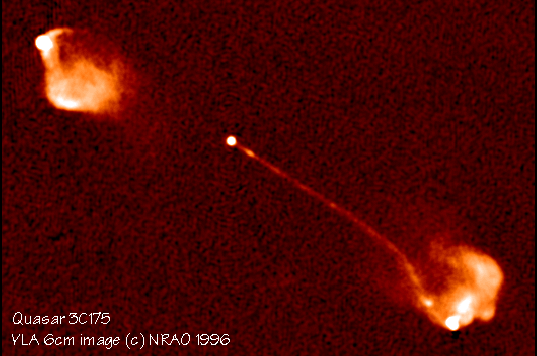 Pulsars and active galaxies: energetic
phenomena powered by rotating compact objects through
their plasma magnetospheres.
|
|
The Spacetime Approach
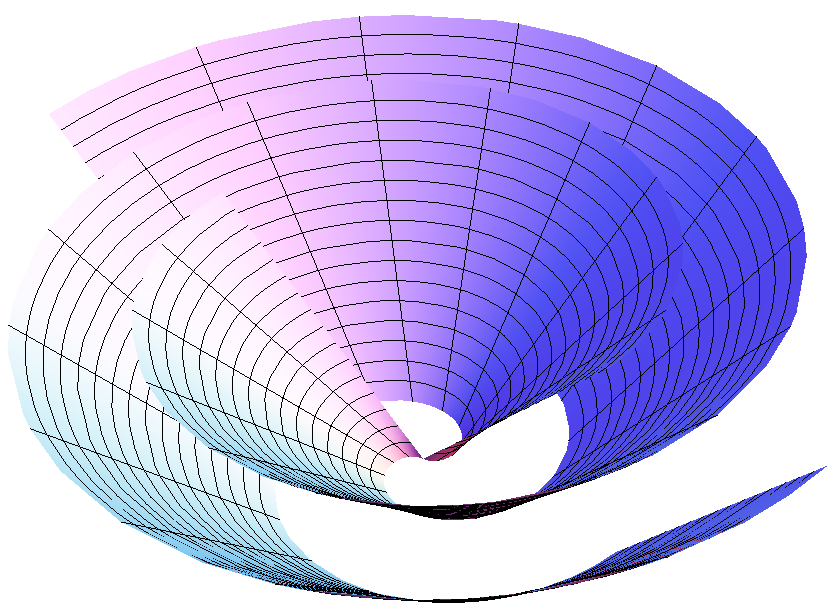 The spacetime evolution of magnetic field
lines, or magnetic field sheets, of a pulsar.
|
|
QED Corrections
Pulsars have unfathomably strong magnetic fields--millions to trillions of times stronger than the strongest magnets here on earth. Towards the upper end of this range, the pulsars are generally called magnetars and exhibit different phenomenology. Coincidentally or not, the transition to magnetar behavior lies right about where the field is strong enough that zero point cyclotron energy of an electron equals its rest mass, indicating the onset of the effects of quantum electrodynamics (QED). The main new effect is the introduction of non-linearities into Maxwell's equations, which can be interpreted as a non-linear susceptibility of the vacuum to due vacuum polarization. We incorporated QED corrections in to the description of a force-free plasma, laying a foundation for future detailed studies. 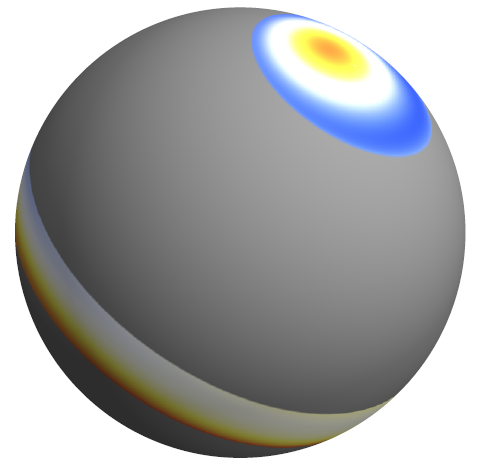 Polar cap current flow of a pulsar with
non-dipolar magnetic field.
|
|
Realistic Pulsar Parameters
The theory of the pulsar magnetosphere has mostly focused on dipolar magentic fields, flat spacetime, and rapid rotation rates (which makes numerical work easier). These assumptions are all violated for real pulsars. We realized that all three could be relaxed with a combined numerical-analytical technique that uses the rotation rate as a small parameter. This makes it very efficient to explore the effects of nondipolar fields, such as the superposed dipole and quadrupole shown to the right. We find that the region of current outflow can be shifted from the pole, which could explain the modified beam characteristics of a class of pulsars called millisecond pulsars. We have also used these techniques to improve X-ray radiation models, offering the potential to explain the puzzling light curve of the pulsar J0437.The Relativistic Two-Body Problem
| |
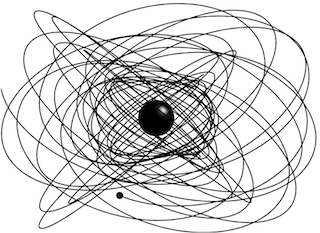 An eccentric orbit about a rotating black
hole.
Image credit: Steve Drasco. |
The Gravitational Self-force
I have worked extensively on the regime where one body is much more massive (and hence much larger) than the other, which occurs in nature when a neutron star or stellar black hole is scattered into a close orbit about a supermassive black hole. These orbits can be quite intricate (see figure to the right, or view movies here), and the resultant gravitational radiation carries detailed information about the system. Precision theoretical modeling of the system requires going beyond the test-body approximation for the compact object to include the influence of its own gravitational field on its motion, i.e., one must include gravitational self-force effects. I have worked on the foundations of this problem, on the role of the central body, on alternative gauge (coordinate) choices, and on including next-to-leading order effects. I have also worked on the electromagnetic self-force problem. 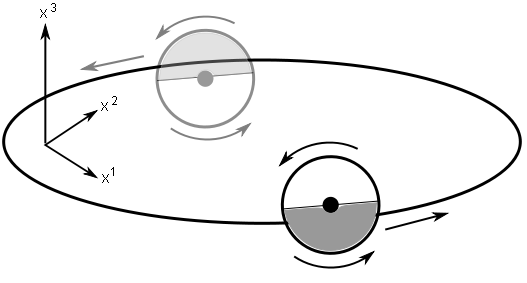 A diagram illustrating a kinematical
effect that makes spinning bodies bob.
|
|
Black Hole Bobbing and Kicks
When binary black hole spacetimes were finally simulated within full general relativity, there were some big surprises. One was that certain configurations of spinning black holes display "bobbing and kicks": the holes bob up and down together while they orbit and inspiral, and the final merged black hole receives a tremendous velocity kick in the direction of the bobbing. How much of this is new, interesting black hole physics, and how much is plain old kinematics? It turns out that the bobbing motion is a kinematic special-relativistic effect, analogous to Thomas precession, that occurs whenever two spinning bodies are held in orbit by any sort of force. Two spinning balls connected by a string will bob just in the same way as black holes. The kick, however, is more special and can only occur for systems that possess field momentum which can be radiated to infinity. After studying an electromagnetic analog, we concluded that bobbing and kicks are basically unrelated phenomena which happen to be correlated when the interaction force is gravitational. We bolstered this conclusion by giving an electromagnetic example in which large kicks can be obtained with no bobbing at all. This latter study touched on the phenomenon of "hidden mechanical momentum" (e.g., Griffiths electromagnetism example 12.12).Scattering and the Scoot
Scattering of massive bodies in general relativity is a clean problem that touches on basic issues in the theory, such as the observability of particle position and the notion of asymptotic flatness at timelike infinity. Results in scattering also inform efforts to model bound systems relevant to gravitational-wave astronomy via their shared functional dependence on system parameters of the two-body problem, and have deep connections quantum scattering methods and results. We revisited the problem using self-force methods, reproducing old results and finding some new surprises. In particular, we have found that the center of mass of the system (or, more precisely, its relativistic mass moment) undergoes a shift during the scattering process--a "gravitational scoot". In an electromagnetic analog the effect can be understood as a permanent, non-radiative exchange of mass moment between particles and field. At higher order there will also be radiative contributions to the gravitational and electromagnetic scoots.Fundamental Issues
While the main thrust of my research aims to understand physical processes at work in our universe, I am interested in more fundamental questions as well. Here are some brief descriptions of my sporadic attempts to address them.Universality
A recurring theme in physics--perhaps even the reason physics works--is the emergence of universality in making approximations; that is, the fact that microscopic details manifest in a finite number of calculable (or measurable) parameters. Any insight into why this occurs seems important to me. In the context of the motion of bodies, I wrote wrote a pair of papers showing how diffeomorphism symmetry plays the key role. (This also provides an efficient derivation of the equations of motion in a large class of theories.) I have also studied the emergence of universality in perturbations of extremal black holes. We managed to show at a technical level that decay (and growth--see instability discussed above) rates both on and off the horizon take a universal form in extremal black holes in any spacetime dimension. Here the key property is the emergence of a symmetry near the horizon.Black Hole Thermodynamics
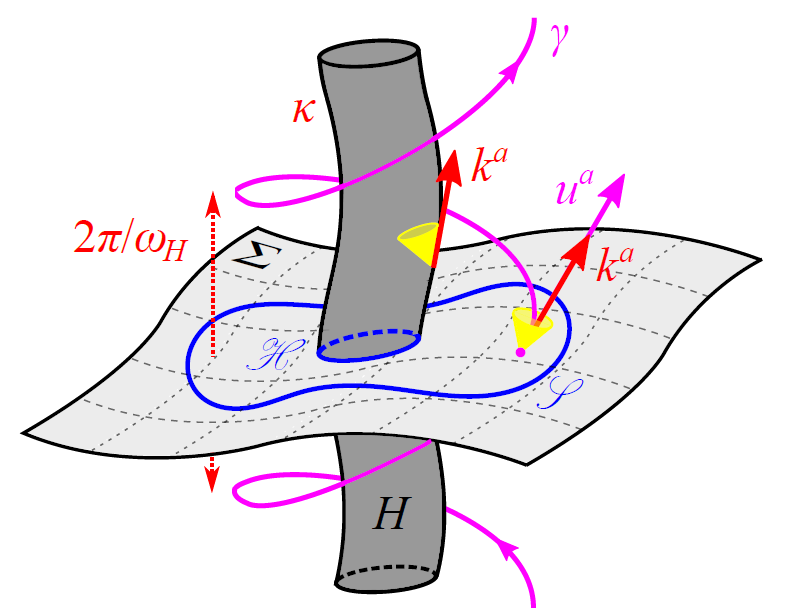 Spacetime diagram of a black hole with a
corotating moon.
|
|
